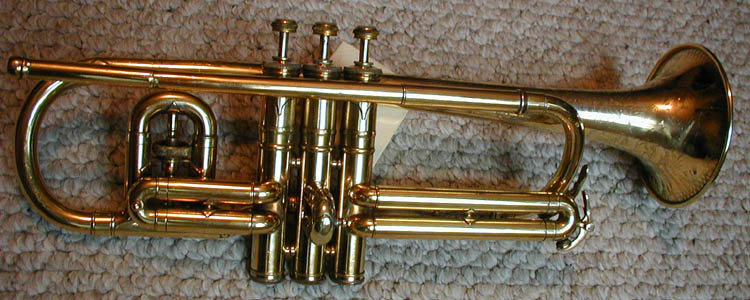Conn 6A Victor

Date: 1927. Owned by Ron Redding
The 6A "Small Bore Victor is the "without mechanism" version of the 4A Small Bore Victor, which does have a mechanism. The 6A is a "Low Pitch" instrument, the "High Pitch" version was the 7A Victor. The 6A Victor is from the 80A family of cornets. The main differences between the 6A and the 80A are in the bore and the length of the instrument. The 6A's bore is 0.462" while the 80A is between 0.472" and 0.478" for the early 80A ("with mechanism") and 0.484" (#2½) for the later 80A ("without mechanism"). The 6A is also longer; the 80A is 16¾", the 6A is 17". Read the booklet Conn included with these instruments, entitled What you should know about this instrument for more on the "mechansim", the micro-tuning mechanism (a.k.a. opera glass tuning slide) and the adjustable spring strength. The 6A was produced between at least 1927 and 1930.
The above pictured 6A appears to be of a "00" finish (see Conn "Finishes"). The extensive engraving on the bell is not obvious in this picture, but it does extend all the way back to the bell curve. Apparently the engraving depicts a house and tree scene. The owner describes its playing qualities as "It plays wonderfully. It has a rich mellow sound and can really sing." One (small) mystery about this instrument. Ron Redding tells me there is a letter "A" stamped on the second valve between the valve number ("2") and the serial number. He also says this is definitely a Bb instrument.
Apparently the third slide, without the finger ring to adjust the pitch of a low D and C#, is slightly longer than it is on modern instruments. On modern instruments the low Eb is in tune, but the low D and C# are quite sharp. On these older cornets with the longer third slide no finger ring the Eb is a bit flat and the D and C# are slightly sharp, but not as sharp as they are on later instruments. It was thought that the flat Eb and slightly sharp D and C# were within the abilities of the player to lip into tune.
As far as I can tell at this point, all Conn cornets built before 1958 take a short shank cornet mouthpiece as opposed to the 2¾" "Bach-style" long shank cornet mouthpiece. The long shank cornet mouthpieces won't properly fit a pre-1958 Conn cornet and won't give the proper intonation or playing characteristics of a short shank cornet mouthpiece. All of Conn's "Connstellation" cornet mouthpieces are long shank mouthpieces. The "Improved Precision" Conn mouthpieces such as the Conn 4 are long shank if there is a "ridge" halfway down the shank, and short shank if there is no ridge (in which case it is a "Precision" mouthpiece). All Conn cornet mouthpieces built before the "Improved Precision" series (ridge), such as the "Precision" series (no ridge) are short shank mouthpieces.